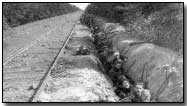Encyclopedia - Body Lice
 Lice infestation was the
norm in the trenches - it is estimated that up to 97% of officers and men
who worked and lived in the trenches were afflicted with lice. It was
decidedly a trench phenomenon. Men who returned home on leave were not
likewise affected and the end of the war in November 1918 brought an end to
the problem of infestation.
Lice infestation was the
norm in the trenches - it is estimated that up to 97% of officers and men
who worked and lived in the trenches were afflicted with lice. It was
decidedly a trench phenomenon. Men who returned home on leave were not
likewise affected and the end of the war in November 1918 brought an end to
the problem of infestation.
Fortunately for the lice population, if not for their hosts, conditions of trench warfare proved ideal for their rapid spread. Of the three types of lice - head, pubic and body - the latter was far and away the most common. Lice could only thrive in warm conditions - which was provided by body heat and clothing.
In spreading from person to person lice required close proximity of a new potential host - and this was readily provided as men huddled together to preserve a degree of warmth.
Also commonly referred to as 'chats', Lice often spread disease, the unique so-called Trench Fever. Lice who had sucked the blood of one infected person quickly succeeded in spreading the infection to each successive host. Trench Fever, although not usually life-threatening, was often highly debilitating and resulted in a trench casualty rate of up to 15%.
Men would gather in groups to de-louse themselves (i.e. 'to chat'). One favoured method of eradicating lice was to quickly run a lit candle along the seams of clothing, where lice would typically converge.
Although this - and occasional immersion of clothes in a solution of Naphthalene - would bring temporary relief the problem soon re-asserted itself as lice eggs which remained undetected in clothing would hatch within a matter of hours; frenzied scratching did not help. Lice - pale fawn in colour - would produce blotchy red marks across the body and leave behind a faintly sour smell.
Lice reproduced with remarkable speed. Each female could produce as many as a dozen fresh eggs per day, which would hatch within a month (and often within half half that time). The fact that men would only be offered a full bath two or three times per month merely exacerbated the issue.
The lice problem was never determinedly tackled by the military authorities given that its connection with Trench Fever was not recognised until the final year of the war.
"Devil Dogs" was the nickname given to the U.S. Marines by the German Army.
- Did you know?
